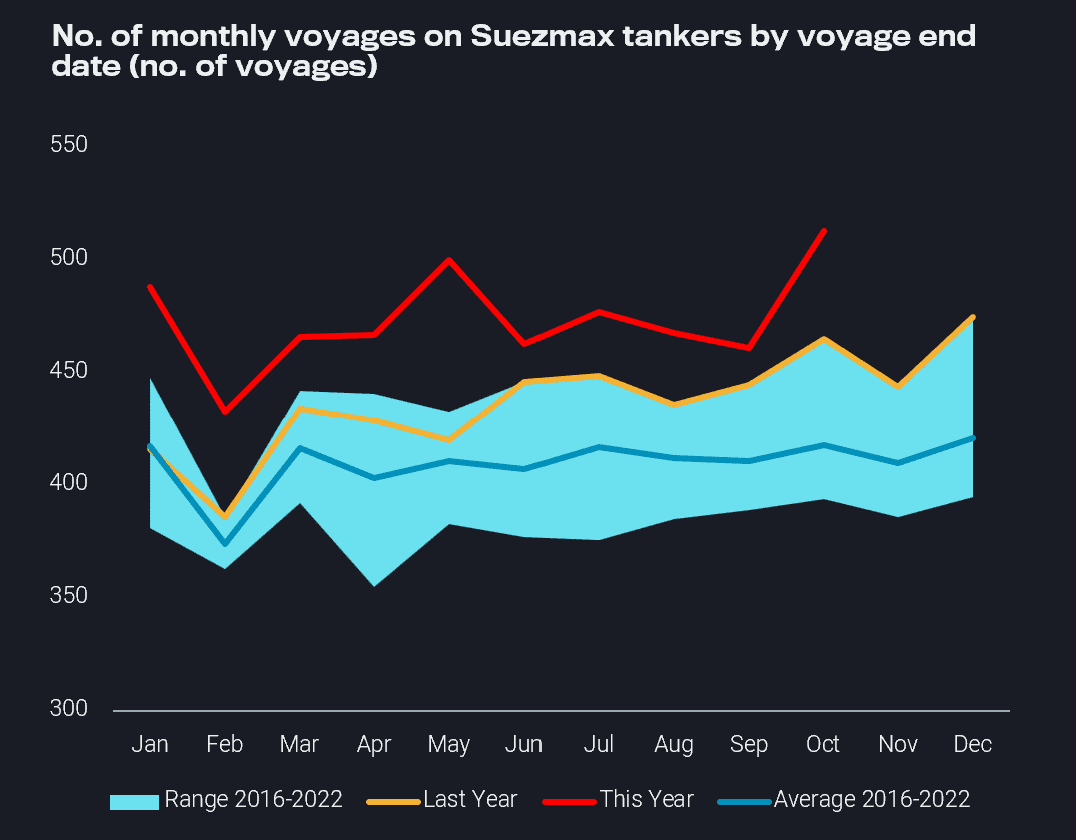Atlantic Basin driving high Suezmax performance even as long-haul Russian employment falters
Despite average voyage mileage reaching a 2023 low, a record-setting number of voyages and high tanker demand from West Africa was enough for Suezmax freight rates to reach 2023 highs in October.
Suezmax freight rates have surged to 2023 highs over the past month, but average mileage for all completed voyages on Suezmax tankers has continued to decrease for the past three months and is well below seasonal averages. Utilisation is increasing due to a high number of voyages but has not yet reached the multi-year high seen in April.
Low mileage can be partially explained by declines in longer-haul Suezmax voyages originating out of Russia. In particular, China’s imports of Russian crude on Suezmaxes from long-haul origins were at a five-month low in October, limiting opportunities for the long-haul journeys out of Russia.
Over the summer as Russian crude exports declined, some vessels began shifting from the Russian trade to the MEG, where employment opportunities are shorter-haul than Baltics-to-EoS destinations. This pattern has continued throughout recent months, which also contributes to lower average mileage.
However, over in the Atlantic Basin, robust Suezmax utilisation out of the USG, South America East Coast and West Africa for destinations WoS has been the driver behind the freight rate increases. This also explains why mileage has dropped but voyage count is at record-high levels. Suezmaxes are fulfilling demand for shorter-haul trade, and the star of the show behind Atlantic Basin support for Suezmaxes in October has been West Africa, where tonne-day demand WAf-to-Europe reached multi-year highs.
From a seasonal perspective, the number of global voyages completed in October is 22% higher than the seven-year seasonal average and is about 11% higher m-o-m. Hence, despite a 15% m-o-m decline in average mileage during October the surge in voyage count explains why Suezmaxes freight rates reached 2023 highs last month.
Utilisation from Russia to longer-haul destinations in Asia Pacific is increasing and is currently at a level last seen at the beginning of July, which points to an increase in average mileage in November and continued upside in Suezmax demand. Additionally, transatlantic flows will remain healthy, which favours Suezmaxes and will keep voyage counts at high levels.
However, despite these bullish signals, headwinds could be on the horizon. Questions remain about the viability of continued robust demand in WAf. Regardless of Europe’s appetite for WAf crude, it is capped by continuous underinvestment in upstream projects in the region. Additional uncertainty also lies in the outlook of Suezmax rates in the Middle East, where rates are currently supported more by political instability rather than fundamentals.

